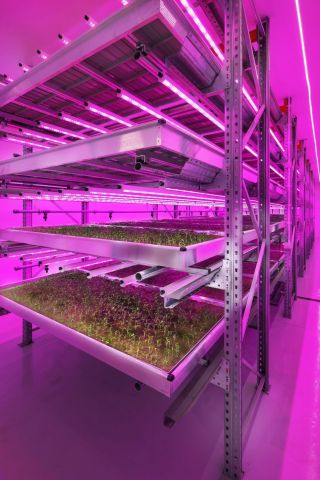Current, powered by GE celebrated the opening of CHAPs new Vertical Farming Development Facility, supported by Innovate UK and based at Stockbridge Technology Centre (STC).
 Researching the Farm of the Future
Researching the Farm of the Future

Contributed by | Current, powered by GE
Current, powered by GE today celebrated the opening of CHAP’s new Vertical Farming Development Facility, supported by Innovate UK and based at Stockbridge Technology Centre (STC), which leverages the company’s Arize horticultural lighting solution to propel commercial urban farming success in the UK. The state-of-the-art research facility, located in Selby, North Yorkshire, is designed to help entrepreneurs, growers and investors gain deeper insight into the technology and environmental parameters needed to optimise crop yields before breaking ground on their own vertical farming operations.
Modelling the Farm of the Future
In its 2017 report, Global Market Insights, Inc. predicted that the vertical farming industry (both indoor and outdoor applications) will grow from revenue of $2.5 billion USD in 2017 to $13.9 billion USD in 20241 and the new facility is designed to support this trend. By testing the latest technology and approaches relevant to this production model, the STC will improve the industry’s understanding of ideal indoor farming crop light requirements and growing conditions.
Potential investors and vertical farmers can work with STC’s plant scientists and vertical farming experts to identify and test the perfect vertical farm setup to maximise their planned harvest’s size, nutritional value and visual appeal. In a controlled environment, they are able to monitor and tweak parameters such as the length of the growing day, C02 concentration, humidity, nutrients and temperature, to ensure that their proposed farm will be commercially sustainable prior to construction. The resulting data supports business planning activity and minimises risks previously associated with vertical farming.
This “farm of the future”, built by systems integrator GrowStack working in conjunction with TCE Electrical Ltd., is the latest research initiative to be led by CHAP and Stockbridge Technology Centre (STC), a pioneer in experimental and applied horticulture research since the 1950s. Since its inception, STC has acted as a bridge between academia and commerce, sharing valuable research and insight that has helped to revolutionise farming practice in the UK.

The installation contains two identical grow rooms - a total growing area of 228m2 - with full climate control and a recirculating hydroponics system as well as futuristic propagation and germination rooms. Four tiers of cropping racks are lit by 780m of Arize LED lighting, delivering a balanced spectrum of red and blue wavelengths that will help boost the development of a broad range of plants.
“As cities’ populations grow at an exponential rate, the demand for fresh produce grows as well,” states Dr Rhydian Beynon-Davies, head of novel growing systems at STC. “We have the potential to grow more produce at an industrial scale within our cities and the focus of this new facility is to support the growers who are taking this bold step into the future of farming. By developing controlled environment grow systems integrated with LED lighting, we can demonstrate how, through technology, urban farming can improve the supply and nutritional value of food in a way that is commercially viable.”
Shining a Light on the Potential of Urban Farming with Arize
“Over the years, Stockbridge Technology Centre has been at the forefront of innovation, devoted to one of the most fundamental industries in the UK – that of feeding the population,” comments Malcolm Yare, Horticulture Business Development Manager for Current by GE. “Light is critical to the success of any crop and by focusing on combining the most effective wavelengths with the optimal environmental conditions, we can help growers outpace traditional methods by creating more “farmable space” in industrial and urban areas, increasing global harvests in a way that is both commercially and environmentally sustainable.”
The Arize range of horticulture solutions has been developed based on Current by GE’s experience in intelligent, connected industrial lighting, combined with extensive research and collaboration with horticulture and agriculture experts. The lights have been designed for easy, plug-and-play installation and are also fully sealed and IP66 UL Wet rated for easy cleaning in high-care, cleanroom environments. Arize lighting is one of the most energy-efficient solutions on the market, using less energy to power the LEDs and generating less heat to tax the facility’s cooling systems. With a 36K-hour lifetime (L90) and five-year warranty, the horticulture lighting solutions allow growers to amortise their capital expenditure over a longer period for greater return on investment.
About Current, powered by GE
Current is the digital engine for intelligent environments. A first-of-its-kind start-up within the walls of GE (NYSE: GE), Current blends advanced LED technology with networked sensors and software to make commercial buildings, retail stores and industrial facilities more energy efficient & digitally productive. Backed by the power of Predix*, GE’s platform for the Industrial Internet, and a broad ecosystem of technology partners, Current is helping businesses and cities unlock hidden value and realize the potential of their environments.
The content & opinions in this article are the author’s and do not necessarily represent the views of AgriTechTomorrow
Comments (0)
This post does not have any comments. Be the first to leave a comment below.
Featured Product

